Raised bed - offers
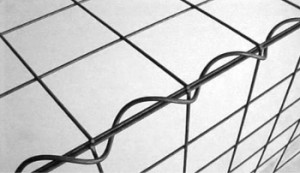 You have decided to buy gabions - now what?
You have decided to buy gabions - now what?
You do not necessarily have to hire a specialist to set up gabions. With a little craftsmanship and the right "ingredients", you can build the gabions yourself and use them as privacy screens, noise barriers, gabion fences or decorative elements in the garden.
So that you don't experience any nasty surprises when setting gabions and don't forget any important construction elements, we have compiled all important aspects on the subject of "building gabions yourself" in a gabion construction manual for you.

Screens, noise barriers or borders with a gabion fence offer great scope for garden design. Even a raised bed made of gabions or seating for the terrace can be created with the stone baskets.
However, the variability in width, height and appearance also requires careful planning. After all, the stone baskets should be stable in the garden, have no gaps and form a harmonious unit.
1. What is the purpose of the gabions? Screening, bordering, fence, slope protection, noise protection, etc.
The decision for depends on this:
2. Dimensions for height, width and depth of the gabions
3. Mesh spacing of the gabions: Depending on filling (stone size)
4. Wire gauge: The higher the wall, the stronger the wire should be.
5. Gabion base: Is a foundation required?
Is anchoring required?
The choice of substrate depends primarily on the size of the gabions and their weight. But also the inclination of the gabions or the position on the slope has an effect on the question: Set up gabions with or without foundation?
6. Selection of the filling material: In addition to stones, it is also possible to fill the gabions with glass.
7. Which connectors should be used? Edge wire grids with spirals or C-rings or eyelet grids with a plug?
8. Possible clarification of the local building regulations, because there may be special specifications for gabion shoring with regard to visual protection and demarcation from the road, which differ depending on the building authority.
A gabion configurator or a fence gabion configurator is helpful when planning to build gabions yourself. This allows you to select the number of wire meshes or baskets, the length, the mesh size and other important features. Another advantage of the configurator is that you will immediately receive a price for the gabions material costs.
The choice of material is partly dependent on the gabion size, the locking system and the type of construction. This in turn determines the choice of tools. The following list is therefore to be understood as a complete list of all devices and materials that can be used for building gabions yourself. Therefore, please select the accessories suitable for your project. Further information can be found under "Background for gabions".
Material:
Tools:
Equipment:
Which stones you fill into the gabion baskets is largely up to your taste, your ideas or your wish. Natural stones are often used for optical reasons, but gravel is also possible. Alternatively, you can also fill the gabions with large pieces of glass.
However, it is important that the stones meet the following quality requirements:
There is no such thing as t h e gabion underground. If you decide to build your own gabions, you will have to make the fixing of the ground dependent on the type of wall (size and perimeter), the condition of the ground and the position of the gabions in the garden. It is also important that the ground is evenly straight so that the gabions have a firm hold. If the soil is less permeable, you should also add drainage.
If you are unsure which subfloor has which requirements, it is better to contact a gabion specialist. The stone baskets as gabion fences, raised beds or privacy screens only meet the requirements for durability and safety if your gabion substrate has been adapted to the respective requirements.
In most cases a "frost protection foundation" is completely sufficient. You dig a foundation trench, install antifreeze material (according to the installation instructions), compact it in layers using a vibrating plate, remove the surface and place your gabions on it.
A gabion foundation is required in the following situations:
If the soil in the garden is relatively soft, wet and generally unstable, you should also opt for a gabion concrete foundation. The simplest solution is a strip foundation whose size corresponds to the future gabion support surface - approx. 10 cm wider than the gabion basket!
Very important when setting gabions with foundations: the weather conditions must be right for the concrete to harden properly. Both when pouring concrete and a few days later, it should be largely dry and frost-free.
Anchorages are particularly recommended when a thin, high gabion wall is involved. Galvanized steel posts (round or rectangular) are usually used as fastenings.
The safest method of fixing is to concrete in the galvanised steel pipes according to the installation instructions or to screw the base plates to the foundation with heavy-duty dowels.
Gabions concrete foundation - step by step assembly instructions
Setting a gabion foundation does not require any special expertise, this is also quite easy for laymen to implement - even easier with our step-by-step guide to setting gabions in concrete.
The foundation size depends on the dimensions of the gabions. Therefore, first mark out the area to be concreted with small wooden piles in the corners of the foundation. Connecting the piles with a string facilitates straight alignment.
For details on the foundation depth, please refer to the installation instructions. This ensures that the foundation can withstand the loads of the gabions and will not be damaged by frost. Depending on the condition of the ground, you will need a hoe, a spade or a shovel to excavate.
The extent to which the boarding must be fitted with wooden boards depends on the condition of the ground. If the floor is firm and does not crumble too much, the formwork at the upper edge is sufficient. Since the upper formwork limit is also the upper edge of the foundation, you must align the formwork with a spirit level.
For a long gabion wall in the garden, neither a bucket nor a wheelbarrow will suffice for mixing concrete. You can borrow a concrete mixer in DIY stores. You will need the following raw materials for the concrete:
The exact mixing ratio is indicated on the cement bags. In normal concrete, the mixture consists of 4 parts gravel, 1 part cement and water in the amount of approx. half of the cement. Add the water only little by little and make sure that the concrete does not become too liquid. Ready-mixed concrete can be recognized by its shine, viscosity and uniform mixing of all elements.
Process the concrete for the gabion foundation as quickly as possible, as the compound hardens quickly and is then difficult to use.
The easiest way to transport large quantities of concrete is with a wheelbarrow and pour it into the excavated hole. However, pour slowly to prevent the formation of larger air bubbles. When using reinforcement mats, first fill only half of the hole, insert the mat and then fill the trench completely.
Fencing gabions must be fastened with posts, which in turn must be anchored in a concrete foundation. Here you make a point foundation - at a maximum distance of 150 cm. Fill half of the hole with concrete, insert the post, refill the remaining concrete and level the post with a spirit level.
The process of installing gabions depends on the choice of the raw material, i.e. whether you choose gabions single baskets or single grids. Single gratings offer the advantage that material can be saved during construction, namely in the form of a monolithic structure. Here, the gabion wall does not consist of several individual parts, but of a block in which the baskets that meet are only separated by a grid wall. However, this of course only makes sense when relatively large gabions are involved.
A further advantage of monolithic construction is the absence of gaping joints in curved or sloping gabion walls. There is no need to offset the joints, resulting in an even, visually appealing stone appearance.
In the following Gabion assembly instructions, both variants - the choice of individual grids and gabion baskets - are taken into account. If you decide to build your own gabions for the baskets, the relevant assembly points start at point 3.
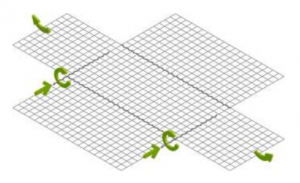
Connect the grid bottom on all four sides with the appropriate wire grids - with a C-ring connection or a spiral connection. The C-rings offer a weaker connection than the spirals, but are sufficient for smaller gabions, as they are often used in gardening and landscaping.
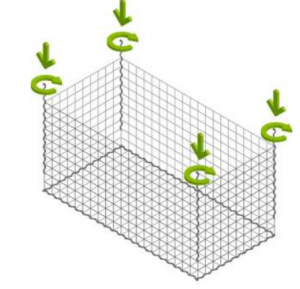 Place the side walls vertically and connect them with the connecting materials listed above.
Place the side walls vertically and connect them with the connecting materials listed above.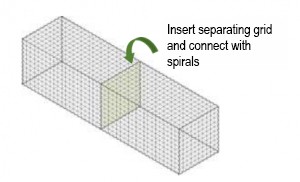

Place the baskets at the desired location on the terrace, garden or property boundary and connect the adjacent baskets with C-rings or spirals.
Spacers ensure that the gabion baskets retain their straight shape. Proceed as follows: With a basket height of 100 cm, insert the brackets at a distance of 30 cm from the top and bottom.
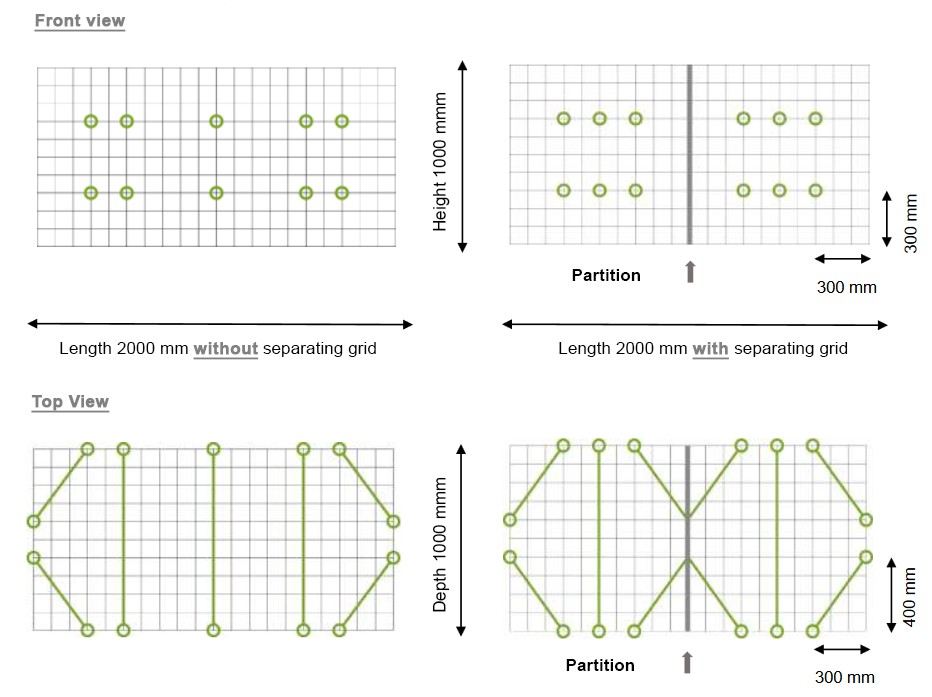

Use squared lumber with dimensions of at least 3 x 5 cm and fasten it lengthwise on both sides at the height of the spacers. They prevent the grilles from bulging during filling.
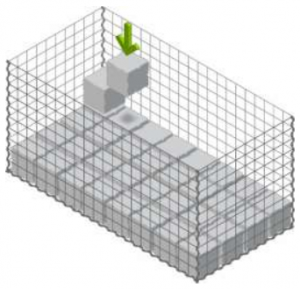
Fill the baskets with material suitable for the mesh size. Make sure that the spaces between the stones are as small as possible. While small stones can still be filled quite well by pouring, larger stones cannot be filled by hand (manual layering).
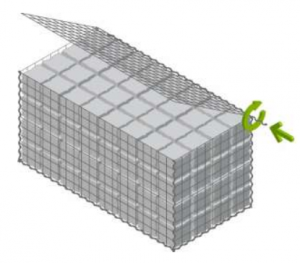 Once the gabion is filled to the top, place the wire cover on it and secure it with spirals or C-rings.
Once the gabion is filled to the top, place the wire cover on it and secure it with spirals or C-rings.
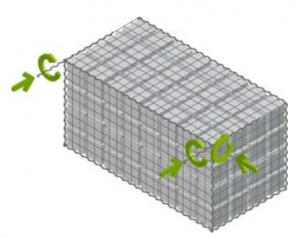
If further layers are to follow the first gabion layer, it is best to pour a levelling layer with smaller stone material into the lowest layer directly under the lid. This way the under layer will not deform so easily if more weight is added.
Building gabions yourself may take some perseverance, but with the right tools, the right materials and good preparation it's no problem. To ensure that the gabion wall in the garden looks the way it should and lasts for a long time, however, exact planning is indispensable - this applies above all to the gabion foundation.
Also not to be underestimated is the choice of stones (suitable for the mesh size and weather-resistant quality) as well as the correct layering.
Our professional tip: Remember that the load is transferred via the filling material, not via the grids! Therefore, always fill with as few cavities as possible and adjust the stones if necessary, especially if you pour the stones in. Even then, most of the stones have to be compacted by hand.
This website uses cookies
In order to optimize our website for you and to be able to continuously improve it, we use cookies. In order to be able to fully use the functions of our website, please consent to their use.
Necessary cookies help make a website usable by enabling basic functions such as page navigation and access to secure areas of the website. The website cannot function properly without these cookies.
| Name | Provider | Info | Expiry |
|---|---|---|---|
| cookieinfo | HS Gabionenshop | Saves the user settings for the cookies. | 90 Tage |
| cms130-session | HS Gabionenshop | Unique ID that identifies the user's session. | Session |
Preference cookies enable a website to remember information that affects the way a website behaves or looks, such as: B. Your preferred language or the region you are in.
| Name | Provider | Info | Expiry |
|---|---|---|---|
| hsgabionenshop-customertype | HS Gabionenshop | Speichert den Kundentyp (Privatkunde / Geschäftskunde) für die entsprechende Preisdarstellung der Artikel | 30 Tage |
| cms130-language | HS Gabionenshop | Saves the language version of a website selected by the user. | 90 Tage |
Statistics cookies help website owners understand how visitors interact with websites by collecting and reporting information anonymously.
| Name | Provider | Info | Expiry |
|---|---|---|---|
| _ga | Registriert eine eindeutige ID, die verwendet wird, um statistische Daten dazu, wie der Besucher die Website nutzt, zu generieren. | 2 Jahre | |
| _ga_* | Enthält eine zufallsgenerierte User-ID. Anhand dieser ID kann Google Analytics wiederkehrende User auf dieser Website wiedererkennen und die Daten von früheren Besuchen zusammenführen. | 2 Jahre | |
| _gat | Wird von Google Analytics verwendet, um die Anforderungsrate einzuschränken | 1 Tag | |
| _gat_* | Wird von Google Analytics verwendet, um die Anforderungsrate einzuschränken | 2 Jahre | |
| _gid | Registriert eine eindeutige ID, die verwendet wird, um statistische Daten dazu, wie der Besucher die Website nutzt, zu generieren. | 1 Tag |
Marketing cookies are used to follow visitors on websites. The intent is to show ads that are relevant and engaging to the individual user and therefore more valuable to publishers and third party advertisers.
| Name | Provider | Info | Expiry |
|---|---|---|---|
| IDE | Verwendet von Google DoubleClick, um die Handlungen des Benutzers auf der Webseite nach der Anzeige oder dem Klicken auf eine der Anzeigen des Anbieters zu registrieren und zu melden, mit dem Zweck der Messung der Wirksamkeit einer Werbung und der Anzeige zielgerichteter Werbung für den Benutzer. | 1 Jahr | |
| test_cookie | Verwendet, um zu überprüfen, ob der Browser des Benutzers Cookies unterstützt. | 1 Tag | |
| ads/ga-audiences | Used by Google AdWords to re-engage visitors that are likely to convert to customers based on the visitor's online behaviour across websites. | Session | |
| NID | Registriert eine eindeutige ID, die das Gerät eines wiederkehrenden Benutzers identifiziert. Die ID wird für gezielte Werbung genutzt. | 1 Jahr | |
| Maps* | Eingebettete Karten / Google Maps | ||
| VISITOR_INFO1_LIVE | YouTube | Versucht, die Benutzerbandbreite auf Seiten mit integrierten YouTube-Videos zu schätzen. | 179 Tage |
| YSC | YouTube | Registriert eine eindeutige ID, um Statistiken der Videos von YouTube, die der Benutzer gesehen hat, zu behalten. | Session |
| yt-remote-device-id | YouTube | Speichert die Benutzereinstellungen beim Abruf eines auf anderen Webseiten integrierten Youtube-Videos | Persistent |
| yt-remote-session-app | YouTube | Speichert die Benutzereinstellungen beim Abruf eines auf anderen Webseiten integrierten Youtube-Videos | Session |
| yt-remote-session-name | YouTube | Speichert die Benutzereinstellungen beim Abruf eines auf anderen Webseiten integrierten Youtube-Videos | Session |
Cookies are small text files that are used by websites to make the user experience more efficient.
According to the law, we can store cookies on your device if they are absolutely necessary for the operation of this site. We need your permission for all other types of cookies.
This site uses different types of cookies. Some cookies are placed by third parties that appear on our pages.
You can change or withdraw your consent from the cookie declaration on our website at any time.
Find out more about who we are, how you can contact us and how we process personal data in our privacy policy.
Please include your consent ID and date when contacting us regarding your consent.